Social Video Trends to Watch in 2021 with the CEO of the Shorty Awards
In this Fireside Chat, we sat down with Greg Galant, the CEO and Cofounder of the Shorty Awards. Listen in or read on to learn about social media trends to look out for in 2021 and how this year changed video production from the creator of the one of the most prestigious social media awards.
Social Video Trends to Watch in 2021
In 2020, social media ruled our lives. Being stuck at home, many people turned to social media to stay informed, be entertained, and keep in touch with family and friends. This meant that video on social media became one of the most popular tools for social connection, and it needed to adapt quickly.
In response, we saw social media trends rapidly changing to fit the needs and interests of people. The platforms tried to keep up and added new features, like Instagram Reels and Twitter Fleets.
But after this unprecedented year, what social media trends will stick? And what will the future of video production look like? CEO and Cofounder of the Shorty Awards Greg Galant had some ideas.
What a Successful Social Video Looks Like Today
With the popularity of video-based social media platforms like TikTok and YouTube, social video has evolved to a new level of entertainment. Content creators are producing high-quality content that works with the constraints of each social media platform, rather than against them.
Greg Galant says that “TikTok is a reminder of how powerful the phone is. It’s no longer just a screen for when you’re away from your computer or other larger screens – it’s something we turn to even when we have our larger screens available.”
But no matter what device we’re streaming on, successful social videos all have one thing in common: authenticity. Take our Shorty-nominated video for example. With real-time reactions and raw filming style, the message of giving back was authentic and memorable.
How 2020 Changed Video Production
This year, in-person video production was one of the hardest hit by the pandemic. However, pandemic constraints on in-person shoots encouraged the industry branch out.
In some ways, the transition to virtual production and livestream video lifted a burden for video creators.
Video created on social media – especially in a pandemic – doesn’t require the expensive, high production value of traditional video. Anyone can sit down and start recording a video through their phone.
According to Greg, “the learning curve is much smaller and cheaper now for people making their own videos on social media.”
More accessibility means the pool of video on social media is only going to keep growing. And more video content means audiences will continue to be exposed to new and diverse perspectives of video.
In 2021, lean into video production that goes against the norm, and embrace the stripped-down quality of virtually produced video to build stronger connections with your audience.
Don’t Forget the Basics
With these observations in mind, know that it’s impossible to tap into every trend in a fast-paced digital world. Remember that hopping onto trends isn’t always a recipe for success.
Even when trends or clickbait seem to be dominating social media, know that those styles can easily be replaced by something new. Instead, make authenticity your priority when developing video for social media.
As Greg put it succinctly: “It’s important to be authentic to people’s reality, but it doesn’t have to be the point of the story.”
Take this with you as you plan your production schedule and video marketing strategy for the new year. And get in touch with us to learn more about how you can put these ideas into action.
FEATURED GUEST
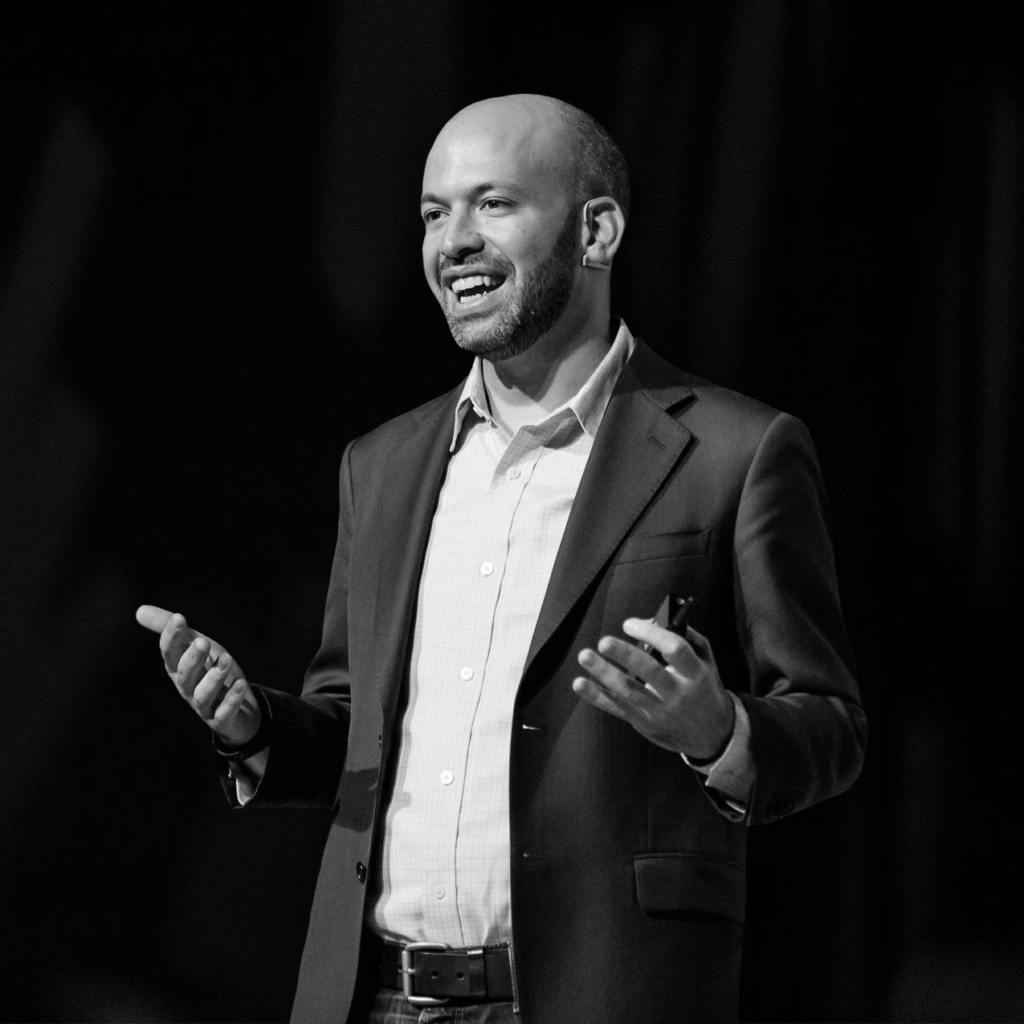
GREG GALANT is the CEO and Cofounder of the Shorty Awards, which honors the best in social and digital media. This year’s winners included Trevor Noah, Zendaya, Rebel Wilson, and Megan Rapinoe. Greg is a prominent speaker, appearing at SXSW, Web Summit, and the Harvard Business School, and has been featured in the New York Times, the Wall Street Journal, and the Associated Press.
The Complete Guide to Video Formatting on Social Media
When it comes to marketing, social video is the proverbial queen of engagement. Marketers in 2020 need to make sure that their organizations focus on developing a strong social video strategy if they plan to remain relevant.
But before you embark on your next social video project, you should be aware of the video file formatting requirements of each of the major platforms. Don’t worry – Green Buzz Agency has you covered! This article will give you all the details regarding aspect ratios, file formats, maximum dimensions, and maximum lengths on a platform-by-platform basis. Be sure to bookmark this page as we will be updating it periodically to ensure you have the most up-to-date information out there!

Facebook remains one of the most popular social networks for the older millennial, Gen X, and boomer generations. From livestreams to shareable post videos to 360 videos to carousel ads, news link videos, and stories, Facebook is truly an all-you-can-watch buffet for video content. It also benefits content creators who favor lengthy videos, say for branded documentaries, with max length up to three hours for carousel ads.

Instagram has soared in popularity since its acquisition by Facebook in the early 2010s. It is one of the preferred platforms for influencer marketing and is now rolling out integrations for e-commerce as well, making it a must-use platform for direct-to-consumer brands.
With stories, video posts, and now video reels as well, Instagram is a treasure trove of video marketing potential and, with “views” requiring three seconds of watch time, every frame counts!
Its various aspect ratio options give you tons of flexibility in deciding what type of video you want to feature. Whether you’re looking at making traditional posts in landscape, portrait, or square, or creating something special for IGTV or ad roll outs, Instagram is a pretty versatile platform for content marketers. Beware, however, long-form content is capped at a max length of fifteen minutes for IGTV and is considerably shorter for other video types.
YouTube

When it comes to ad-supported user-generated content, YouTube is the shining star. YouTube is considered the quintessential video platform and the progenitor of this entire era of digital video-driven content. Many brands have used YouTube as a means of connecting with audiences of all ages. As such, YouTube remains one of the most engaging and sticky platforms out there.
While YouTube is relatively inflexible with respect to technical specs like aspect ratios (for which it only offers 426 x 420 and 16:9), YouTube allows users to upload videos in many different file formats including .MOV, .MPEG4, MP4, .AVI, .WMV, .MPEGPS, .FLV, 3GPP, and WebM. And, with a maximum file size of 128 GB, you have plenty of room for uploading super high quality and lengthy videos.

LinkedIn has led the B2B marketing space for over a decade. More and more professionals (of all age groups) are becoming addicted to scrolling through LinkedIn both on their phones and on their desktops. Creating a LinkedIn profile that attracts followers and draws leads is now a crucial part of every company’s marketing mix.
LinkedIn’s video capabilities have slowly begun to diversify away from the typical shareable post video to include live streaming as well. Max file sizes and minimum resolutions vary depending on whether the video is a post or ad. As such, it is best to consult this page before starting on your LinkedIn video production journey!

Once known for its character-limited tidbits of text copy, Twitter has warmed up to different types of content – video being one of its most salient additions. Twitter is an excellent option for marketers who’s audiences are avid followers (or guilty pleasure readers) of celebrities, politicians, and even the world’s most (in)famous celebrity-politician, @RealDonaldTrump himself.
Marketers should not ignore the high level of engagement that Twitter aficionados have for that platform and should look for ways to incorporate video content to augment their tweets – just remember to aim for quality, not virality. It is, however, worth noting that Twitter has very specific requirements for its video content. No matter what type of video you’re trying to upload, the specs are the same.

When asked to name the platforms they think would be the best for social video, Pinterest likely doesn’t come to mind right away. That being said, Pinterest has steadily grown its user base and continues to dominate in the work-from-home era. Let’s face it: we’ve all gone on Pinterest to figure out how to make the perfect dish in our slow-cookers, look for makeup or hairstyle inspiration, or just marvel at people’s arts and craft abilities. One savvy individual even followed his wife’s Pinterest account to plan the perfect wedding. He managed to do all this relying entirely on the wedding-related posts she pinned on her Pinterest.
Given Pinterest’s uncanny ability to convince people to make, buy, or try products, it is a very natural option for marketers to target with video content. It is also quite simplistic in terms of its specs, with portrait and square as the only video types and .MP4 and .MOV as the only file types supported.
Snapchat

What started out as a way to send people pictures taken on your phone with captions that disappeared after being opened by the recipient has now evolved into an entire ecosystem for social video. Snapchat is far from yesterday’s news. It is finding ways to remain relevant in the multi-platform era.
Snapchat has managed to stay connected with young users and millennials, offering yet another area for marketers to place their ads. Snapchat’s specs are also straightforward, varying only in terms of whether the content is short-form or long-form.
To Sum it All Up
If you are new to video marketing and have additional questions about how to best position your video content on social, please feel free to reach out to our team! We’re happy to help answer any questions you may have.
To Zoom or Not to Zoom: Comparing Live Streaming Platforms for Events During the Pandemic
Now more than ever, video is helping connect audiences across the world and is bringing people closer together. With in-person meet-ups for professional networking and entertainment on pause, live internet-streamed event broadcasting has soared in popularity. With this trend accelerating, it is important for all organizations to consider how live streaming events can improve sales and increase brand awareness.
At Green Buzz Agency, we help our clients create top-quality video content for all their organizational needs. While based out of the Washington, D.C. region, we work with large brands and nonprofits all over the world.
Since the start of the COVID-19 pandemic, our clients have been asking for help with event live streaming. More often than not, the main question our clients ask is what software or platform they should use.
With dozens of options out there, it is difficult for those unfamiliar with live streaming or video production services in general to get themselves up to speed, so we’ve put together a list of the different softwares and platforms, a summary of their key features and pitfalls, and an overview of best practices for you to consider. Hopefully this helps answer questions that you have, but feel free to reach out to us for more information.
First and Foremost: What Are You Out to Achieve?
As with any initiative, it is important to start by establishing what goals you are trying to achieve through live streaming events before diving into a software or service solution. Typically, organizations interested in live streaming events look to accomplish one or more of the following goals:
1. Improve community or customer engagement through social media;
2. Create original content assets; or,
3. Augment or replace in-person live event experiences with a more digital solution.
After you’ve articulated your goals clearly, you should rank each goal from top priority to lowest priority. Ranking will help you narrow down your choices and pinpoint the best live streaming solution for your organization.
Zoom
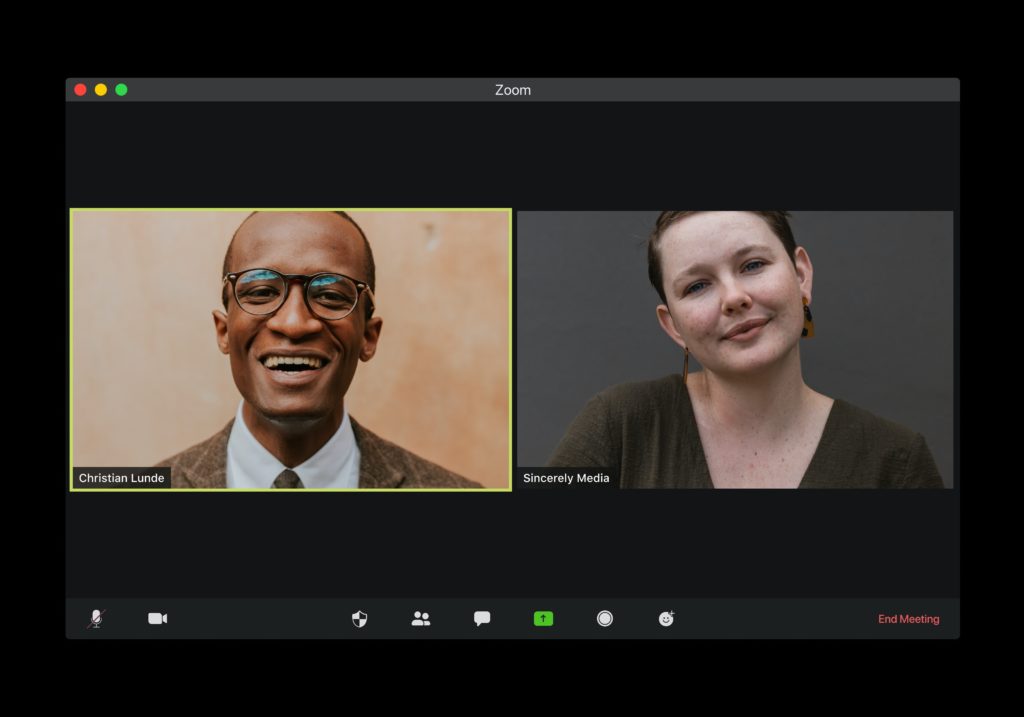
If you’re searching for business-oriented streaming solutions for your events, it’s pretty safe to assume that you’ve heard of Zoom before. The video conferencing app founded by a former Cisco employee has taken the world by storm and has (arguably) achieved a highly coveted branding goal: “Zoom” has become a verb. Zoom is quickly becoming a staple of the work-from-home transition and is often overlooked when it comes to live streaming events.
Zoom is a great low-cost and low-complexity option to live stream your event. Many organizations already have enterprise subscriptions to Zoom and most people are pretty familiar with its interface. Zoom streaming does not require any special skills or training in live video production and is perfectly tailored for events where attendee interaction and participation is needed. It also allows users to stream concurrently on other platforms simultaneously such as Facebook Live and YouTube.
Zoom is not a perfect solution if your needs are highly specialized and you require flexibility. With Zoom, you get what you’re given and have little room for customization.
Bottom line: Zoom is a familiar face and a cost-effective solution but isn’t the ideal option for custom-tailored live streams.
Grabyo
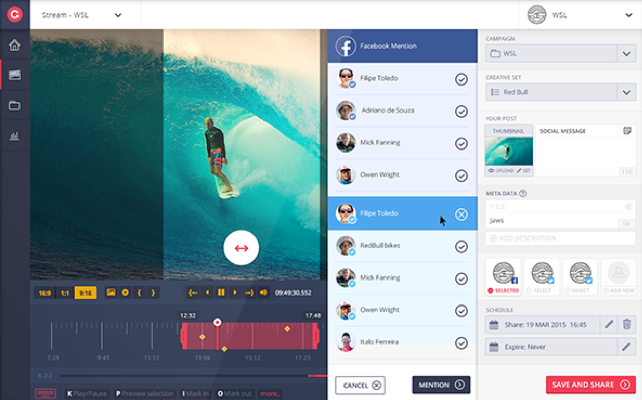
Grabyo is the self-proclaimed “future of broadcast”. It is a robust cloud-based software for live streaming events and is ideal for creating professional quality live programming. Organizations that have the resources to dedicate a small team for live event production will love Grabyo’s team collaboration capabilities and its expansive user customization options.
The program has unique features that allow production team members to clip and post moments from the broadcast to social media in real-time. Grabyo also allows co-streaming via various social media accounts – another major bonus feature for events that are to be broadcast on different platforms.
While Grabyo is great for video production companies or organizations with in-house video capabilities, Grabyo’s interface can be rather complicated for first-time users. Even experienced technical directors will need a bit of time to master its functionality. Grabyo is also ill-suited for events that require audience engagement like webinars or meet-and-greets. In its most current form, Grabyo does not allow communication between the production team and the consumers of the content.
Perhaps most importantly, Grabyo is pricey. Its cost model is bespoke and may be out of reach for small-budget events.
Bottom line: Grabyo is great if you know video, have a medium to large budget, an experienced team, and do not need to engage in real-time with your audience.
StreamYard
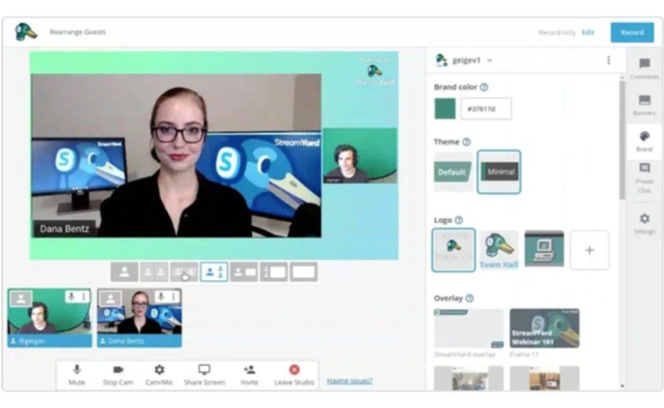
StreamYard is a browser-based platform that brands itself as the “easiest way to create professional live streams”. There is a lot of truth to this statement. In many ways, it is a simpler and less expensive version of Grabyo. StreamYard gives users creative freedom with respect to on-screen and back-end customization and integrates seamlessly with social media. Its platform allows you to communicate with the audience via Facebook Live commenting, which is a major bonus for socially-oriented events. Like Grabyo, you can upload custom graphics files to display overlay graphics, intro and outro videos, and branding.
Apart from price, StreamYard differs from Grabyo in that the former allows only a limited number of users working on the stream at the same time and limits the size and type of video files that you can upload for graphics.
Bottom line: StreamYard is great for lower-budgeted or simpler mid-level productions staffed by a small production team.
Social Media
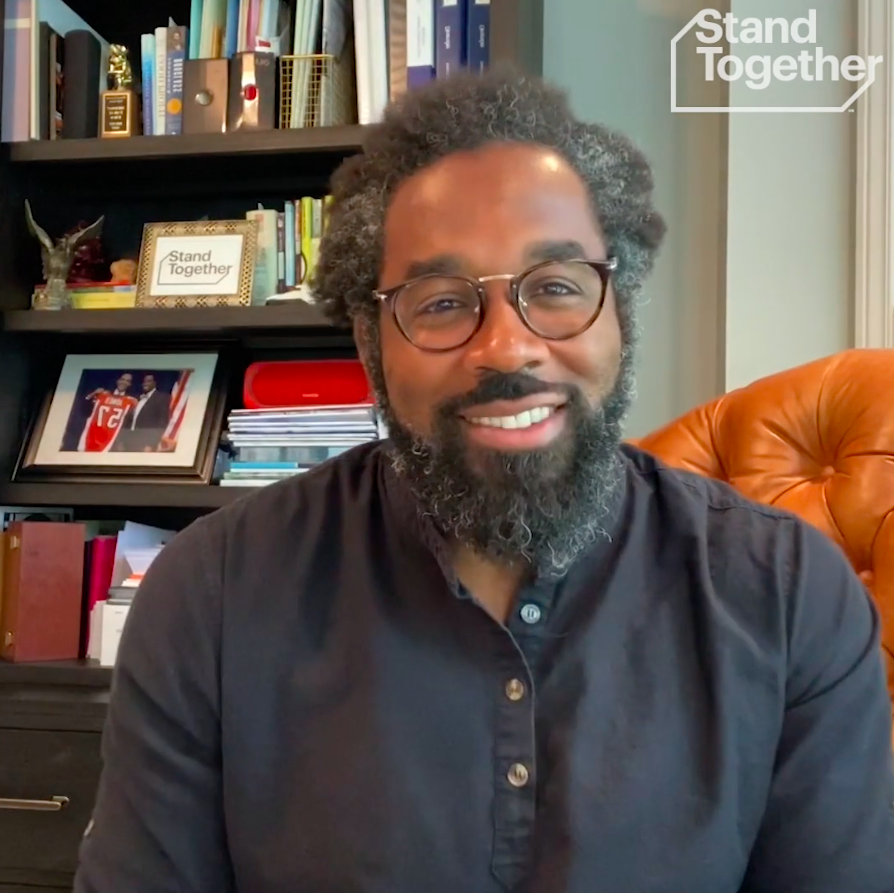
Social is the unsung hero of event live streaming and the queen of video content distribution in the modern age. Streaming through social media platforms is free and your event’s reach can be boosted with paid placements. Social is also the natural start and end point for anything event related. From advertising your event months ahead of time to posting clips and photos after the event, social media is at the center of any event-based marketing campaign.
One of the major downsides of streaming events directly through social media is the low video and audio quality. This pitfall, however, may be an important source of differentiation given the widespread issues that people are having with internet connection reliability.
Many consumers are used to experiencing highly pixelated video quality or audio dropping here and there. So, viewers may find comfort in the familiarity with the experience of watching their favorite influencers and friends live stream their daily lives directly through Instagram, Facebook, YouTube, Twitter, and LinkedIn. This organic feel is perfect for organizations looking to connect with their audience, engage back and forth with attendees, and maximize the exposure that their live events will generate using a simpler livestream.
Bottom line: social is a simple, streamlined way of connecting with a wide audience but the video and audio quality can be subpar, so be warned if you’re planning to repurpose the video footage after a livestream on social media.
Next Steps
While no solution is ever a perfect solution, there is likely a platform or software that works best for your organization’s specific needs. If you are new to video marketing and have additional questions about how to best prepare for your live streamed event, please feel free to reach out to our team. We love to collaborate and are happy to help give you some pointers to ensure that your video needs are met!
Justin Zuccon, Director of Corporate Development.
7 Strategies for Remote Content Creation
With the universal shift to remote online work, a new virtual culture was born. For marketers, this transformation has ushered in a huge shift in the ways consumers engage with brands and consume content. And, content creators have been dealt an entirely new set of limitations in video production.
But, research suggests that constraints actually drive innovation. Given the constraints of our new virtual culture, we compiled 7 ways marketers can drive innovation.
Know Your Audience
Everyone is online. Being able to capture the attention of a wide audience can be impressive, but to really make the most out of our new virtual culture it’s crucial to know your specific target audience. Start with social media – it’s one of the only ways you can directly interact with your consumers during lockdown. This doesn’t mean that you have to rush to every platform. Identify your primary platforms for engaging with your target audience and focus your energy there, first.
Once you’ve identified your target audience, your content strategy can be more personalized to engage that group. Figure out which platforms your audience is drawn to, and then optimize your content to best suit the capabilities of each platform.
Experiment With New Content
In this new virtual culture, chances are a lot of your brand’s pre-planned marketing projects have been put on hold. In place of these postponed projects, take time to explore new online platforms.
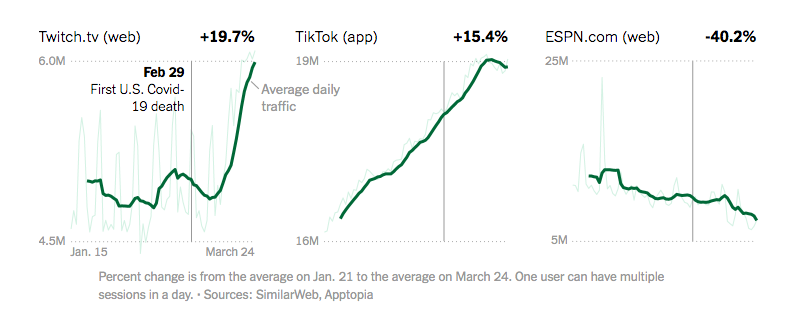
Although podcast listening is down, the NYTimes reports that TikTok usage is up by 15.4%. With popular social media platforms like TikTok, there’s a huge opportunity to build new connections in digital spaces. And, TikTok has the highest social media engagement rates per post, when compared to Twitter and Instagram, making it the perfect platform to retain consumer attention. TikTok videos generally have a very basic production value, making it easy to produce content for the platform within our new virtual culture.
In place of podcast listening, consumers have gravitated towards more visual insight through webinars. Dipping into the world of webinars allows your brand to connect with thought leaders in your industry, while also providing valuable on-demand information. Plus, webinars allow for a more open line of communication between your brand leaders and your audience. With question and answer segments, webinars foster a space for live discussion in this new virtual culture.
Creative advertising agencies, including our own Green Buzz team, have taken to webinar programming as a way of leaning into innovative industry education.
Lean Into User-Generated Content
In today’s virtual culture, anybody can be a content creator. And, this extends beyond what we think of as YouTubers. With platforms like Instagram and TikTok adopting livestreaming capabilities and long-form video content, users have the power to create and share like never before. In fact, Instagram Live saw a 70% increase in usage during the month of March in the US alone.
User-generated content (UGC) already had an enormous footprint on the internet, but the pandemic has skyrocketed content creation to new levels. And yet, a lot of marketers haven’t fully accessed its potential for their brands. With consumers in our new virtual culture prioritizing relatability over aspirational content, it’s the perfect time to lean into UGC.
Simplify Your Production Levels
User-generated content isn’t just useful in creating relatable content; it also removes the pressure and cost of creating content with a high-production value. Especially now, video producers are exploring every option for facilitating remote content creation.
But, the new virtual culture created out of the pandemic isn’t the only driver for simplifying production value. Today, consumers are generally more interested in pared down, realistic content.
Plus, with the newest generation of content consumers increasingly skeptical of advertising, marketers need to prioritize authenticity. According to an AdAge study, 84% of Gen Z trusts a company more if they use actual customers in their ads, and 79% will trust a company more if the images its brand uses are not photoshopped. Both of these statistics point to the rising importance of realistic content and user involvement, especially for the future of brand marketing.
Stay Culturally Relevant
With most of people’s social lives now existing on the internet, information travels faster and trends can seem to expire in an instant. But in order to lean into virtual innovation, it’s important to adapt to the speed and tone of online culture.
Marketers should never compromise their unique brand voice to match fleeting trends. However, being aware of consumer perception of industry leaders is an important part of staying relevant. Make sure your team is staying up to speed with what consumers are actually responding positively too. When you’re appropriately engaged, you’ll also have an easier time identifying trends that will stick, and trends that won’t.
Repurpose Existing Content
Even if your team doesn’t have the bandwidth to be creating new content right now, you can transform your existing content for new platforms. By taking existing well-performing video content to new platforms, your brand can expand its reach to new audiences.
Especially when resources are low, repurposing content presents a low investment option for maximizing brand exposure. Try reinventing video content for TikTok, or bringing webinars to IGTV. Expanding into new platforms with old content also serves as a great starting point for your social media strategy. Your well-performing content should already be optimized for your audience, so repurposing that work will only maximize its effectiveness.
Ensure Your Content Can Stand On Its Own
Lastly, make sure that your content isn’t so specific to our current virtual culture that it won’t stand the test of time. Of course, your marketing should always be relevant, but it’s still important for your content to hold up in the future when it exists outside of the cultural context.
To do so, make sure that every message your company sends aligns with its brand values. Your content can be both timely and reflective of your brand’s stated values. Down the line, this ensures that your messaging still comes off as genuine, and not solely opportunistic.
So, what can your marketing team do today to lean into the new virtual culture? First, begin to understand your audience and the online spaces they occupy. Then, lean into the new virtual culture by investing in digital innovation. By embracing our new consumer culture, brand marketers will stay ahead of the curve.
Emily Herman, Marketing and Communications.
Create Video Content that Drives Organic Growth
With people stuck inside, video streaming services like Netflix and YouTube are grabbing all of the attention of content-hungry viewers. As these media giants dominate the market, it might seem impossible to generate organic growth for your own video content. Traditional video production strategies are no longer possible, but consumers are still demanding content.
The rush to adapt to this new landscape of video content has led a lot of brands to push out video content on every available platform. But many marketers fail to ask themselves: who is this content for? Without a clear organic growth strategy, all you’re doing is relying on luck to make your video go viral. To make your own video content break through the noise, focus on increasing organic growth by targeting your audience’s needs and interests during this time.
One major leader that’s emerged in this space is PBS Digital Studios. With over 9.7 billion minutes watched and 84% of its audience spanning ages 18 to 49, PBS’s video content has seen enormous organic growth through digital transformation. By taking their traditional broadcast content and adapting it for YouTube audiences, PBS has been able to stay connected with its viewers during the pandemic, while also continuing to expand their reach.
Be Specific
Before you start churning out content, take a second to consider the purpose of what you’re putting out onto the internet. Are you showing support for your customers? Offering a useful service during quarantine? The internet is overwhelmed with content – focus on quality rather than quantity.
It’s great to have a video production team that can churn out content, especially during this shift to virtual work. But, in order to be successful, your content marketing strategy needs to be specific.
For consumers today, there’s no apparent lack of content. From streaming services, to your favorite beer brands, video content is being produced non-stop. Don’t try to capture the attention of every consumer that’s spending time on the internet right now. Instead, be specific and focus in on your target demographic. Once your video content team becomes specific about its target demographic, the content itself will be more pointed toward organic growth.
For example, Green Buzz has been producing weekly livestream videos for Stand Together’s new #GiveTogetherNow campaign. This new campaign was launched in the wake of the coronavirus, and its use of celebrity hosts – including former NFL player Dhani Jones and National Geographic photographer Jimmy Chin – and livestream optimization has allowed them to successfully target their audience.
Make a Dedicated Plan
After you’ve narrowed down the audience for your content, your marketing strategy can expand beyond the creative ideation of the content. Consider distribution strategy: which platforms does your target audience engage with the most? Try to get a sense of what your target audience is attracted to, while also acknowledging the volatility of consumer trends during this rapidly changing period.
According to the New York Times, the coronavirus lined up with a 15.3% increase in traffic on the YouTube webpage, and 4.5% decrease in traffic on the YouTube app. This data highlights important information about how consumer viewing trends have shifted during the pandemic. Viewers are moving away from consuming content on apps, and have taken to consuming content on desktops or larger screens.
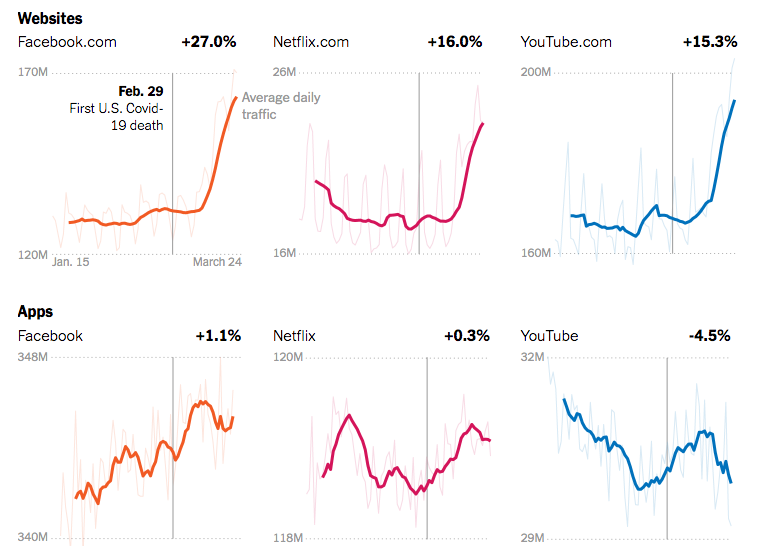
This consumer insight suggests that your video content plan should be tailored to full-screen viewing. Consumers may have longer attention spans, or at least looking for more immersive video content.
Encourage Conversation
Your strategy is in place and your content has been optimized. Now, it’s time to put your content out there. Publish your video content on all of the relevant platforms for your audience. But, your work isn’t done yet. Well-optimized content is great, but in order to encourage consistent organic growth, you need to foster an interactive online community.
Offering a space for conversation will improve your brand awareness, while also showing a more human side to your marketing content. However, the feedback you get won’t all be congratulatory. Having a space for open conversation opens the door for negative responses – but don’t be afraid of constructive feedback or criticism. Ultimately, this type of immediate feedback is useful in guiding your content strategy and staying connected with your audience.
Additionally, the more active you are in these online communities, the more tuned in you’ll be to what its users want to see. Speculating about what content will be successful based on statistics is a great starting point, but it takes continued conversation with your audience to ensure organic growth.
Stay Tuned In
In such a rapidly changing global environment, it’s more important than ever to stay tuned into what your target audience needs most. Plus, with no clear image of what our “new normal” will look like, many brands have turned to sharing their own executive insight. For example, marketing leaders at top brands like NASCAR and Make-A-Wish have stepped up to share how they’re continuing to adapt throughout the coronavirus pandemic.
Plus, Head of PBS Digital Studios Brandon Arolfo shared his company’s own insight into how strategic content creation can allow brands to accelerate growth during this time. In collaboration with Green Buzz Agency’s webinar series, Brandon discussed “Content Creation that Powers Growth and Digital Transformation During COVID-19.” Learn more and stream the full webinar below.
As the economic and social environment around us continues to change, it’s crucial to continue seeking new insight. From consumer needs, to high-level business strategy, staying connected to the ideas and minds within your industry will provide guidance in such an uncertain time. And remember – the best organic marketing strategy is born from a combination of educated insight and thoughtful innovation. Successful video production teams lead with data and creativity.
Emily Herman, Marketing and Communications.
How NASCAR is Using eSports to Keep Sports Alive in Quarantine
Live sports events are a thing of the past. When the coronavirus shutdown hit the NBA in early March, the NHL, NFL, MLB, U.S. Open, and even the Summer Olympics eventually followed suit. Any live sports event was either cancelled or postponed for the distant and uncertain future. Sports fans everywhere were reeling – nearly every form of sports entertainment had suddenly disappeared. But, the solution has been there all along: eSports live streaming. And, the sports best suited for this virtual transition might not be the ones you’d expect.
NASCAR Goes Virtual
Before fans had much time to wonder whether the rest of the NASCAR season was cancelled, the auto racing giant swooped in with a solution. Officially titled the eNASCAR iRacing Pro Invitational Series, the virtual version of this high-adrenaline sport puts real NASCAR drivers behind the wheel of racing simulators to compete on a virtual track.
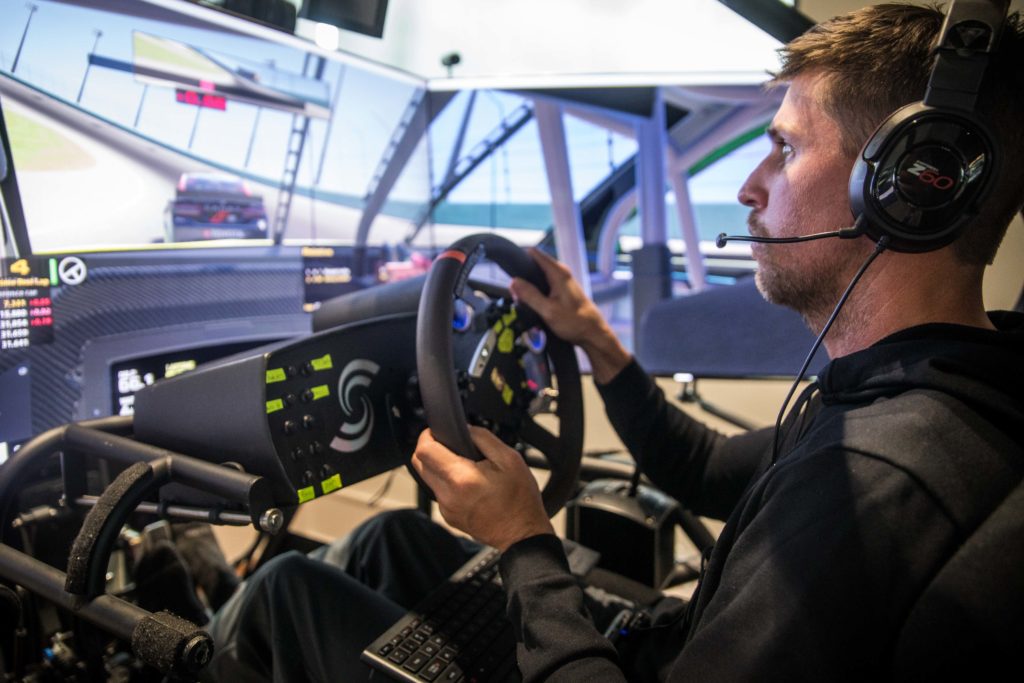
Infamous drivers like Dale Earnhardt Jr., Kyle Busch, and Denny Hamlin are finding themselves behind the wheel of racing simulators from the comfort of their own living rooms. Though a jarring and often funny adjustment, NASCAR’s shift to remote programming has been keeping audiences engaged and excited about the future of sports entertainment.
Auto racing’s virtual transition was almost too easy. Despite a few minor hiccups that come with this new work from home territory – namely, Denny Hamlin’s 7-year-old daughter accidentally ending her dad’s race on the virtual Talladega Track – iRacing has fostered the same energy of their typical races.
Audience Engagement with Remote Programming
With NASCAR fans showing some of the highest levels of brand loyalty and sponsorship support, advertisers are in luck. Advertisers can still buy into sports racing, and there’s an even bigger incentive to do so. NASCAR’s first eSports race was available for online streaming on March 22nd, and it drew the attention of a huge audience of content-hungry sports fans.
Not only were long-time NASCAR fans tuning in to the first ever iRacing Pro Invitational Series race, but 225,000 new viewers also joined in on the event. This begs the question: were sports fans ready for the shift toward eSports streaming all along?
Regardless, new NASCAR iRacing fans have a lot to look forward to. Remote programming has extended virtual racing through at least mid-May, giving audiences some sense of normalcy in the content they engage with during quarantine.
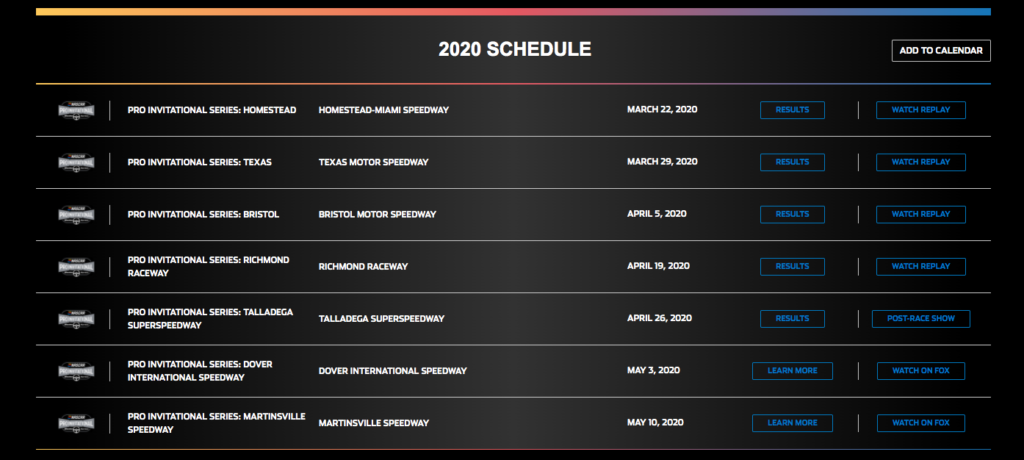
Plus, it doesn’t stop there. Each installment in the iRacing series is uploaded to the official site and the NASCAR YouTube channel. Race stats, real-time commentary, and post-race shows give NASCAR’s remote programming nearly the same energy as pre-COVID races.
New Leadership in Virtual Sports
When the coronavirus shutdown first hit the sports industry, NASCAR’s SVP and Chief Digital Officer, Tim Clark, told NBC Sports, “I think we’re in a unique position in that we’ve got not only sim racers like you see in the (eNascar) Coca-Cola (iRacing) Series but also professional drivers that are able to do this at a high level.”
Although sports executives could have never anticipated the coronavirus and its major impact on every sports industry, Tim Clark knows the adaptability of NASCAR racing to a virtual format puts them ahead. Of course, life-long racing fans aren’t ready to settle for a permanent shift to eSports – and NASCAR’s digital team knows this. Tim Clark told NBC, “we want to strike the balance between having some opportunities to do more in this space but also being cognizant enough to not oversaturate.”
What Can We Learn From NASCAR?
As Chief of Digital, Tim Clark isn’t precious about NASCAR’s insight in virtual sports programming. Auto racing’s leadership in the digital arena has given them the opportunity to lead the way for the “new normal” of sports broadcasting and entertainment.
Along with Entercom’s BJ Barretta, Tim Clark expanded his leadership to Green Buzz Agency’s webinar series. On Thursday, April 30th, Tim and BJ shared their top-line strategies on how to create and program content with agility, creativity, and limited resources. With NASCAR’s virtual racing series setting a new record as the highest-rated televised eSports event ever, this high-level insight is helping to keep producers ahead of the curve. The recorded webinar, along with Green Buzz Agency’s entire webinar series, can be found on Vimeo.
The Future of Sports Programming
It’s impossible to ignore that the coronavirus lockdown has released the gates for the eSports boom. Even the 2020 NFL Draft was held online, making history in the program’s eighty-four year history.
While there’s no clear reopen date in sight for any of the major sports leagues, it is clear that remote sports programming has more potential than it has gotten credit for in the past. Even when sports leagues do get back on track, marketers will need to be tuned into the inevitable change in their audience mentality after months of virtual sports entertainment.
Emily Herman, Marketing and Communications.
How to Really Connect on LinkedIn
Nearly every day, someone asks me, “What’s the best way to get started on LinkedIn?”
Most articles on this topic begin by spouting the ‘steps’ to connecting with others.
I’d like to begin even earlier in that process and talk about you.
Authenticity on Social Networks
Remember how Mom used to say, “Just be yourself and people will like you!” or “If you can’t say anything nice, don’t say anything at all”?
Mom was way ahead of her time.
The real question isn’t, “What’s the best way to get started on LinkedIn?”, but “What’s the best way to prepare myself to get started on LinkedIn?”
You’ve probably heard or read quite a bit about authenticity, transparency and integrity; three key elements to social media success. But can displaying these qualities actually make a difference?
Very simply, absolutely. For anyone looking to really connect on LinkedIn, here’s the starting point. LinkedIn (in fact, social media in general) is about people. Helping, sharing and connecting. If your neighbor’s lawn mower breaks down and he or she asks to borrow yours, you’d likely say yes, because the two of you have a relationship. You also inherently recognize your neighbor will return the favor, or perhaps another type of favor, if you asked. If a total stranger were to knock on your door with the same question, you’d likely say no and immediately think, “the nerve!”
Giving, Not Taking
A genuine, authentic approach to connecting with others is vital. Wrap your brain around this ‘helping’ attitude before you begin. If potential LinkedIn connections smell ‘a pitch’, you’re done before you start. No pitch should be necessary when you’re connecting on a deeper level that says, “Let me help you, just because I can.”
How can you help? Be you; be real; don’t falsify who you are. Get involved in and create stimulating, informative, and valuable discussions others can debate. Or, post your comments and thoughts more privately within groups you have joined.
As people begin to know and trust you, lead generation will begin. This is a two-fold process:
1. As you listen to the real needs of others, you help solve their challenges.
2. When you give help, you get help in return.
I often joke that I keep my expectations low; therefore, I’m never disappointed, but often delighted. It’s not much of a joke, because it’s true. Relationship building takes time. That connection may blow you off with a polite comment today, but may be knocking on your door tomorrow, because you’ve taken the right steps to remain top of mind.
Social media is a marathon, not a sprint. Wishing for it to move faster isn’t going to make it so. You’ve got to do the legwork required. Over time, you’ll be glad you did, as your online reputation and credibility grow.
Interact at an authentic level with everyone you meet, and watch the real magic happen.
Updated on February 12, 2020.
Victoria Ipri is CEO of Modello Media, Inc., an e-marketing strategy firm based in suburban Philadelphia, PA. She welcomes your questions and comments on this forum, or contact her directly at: ModelloMedia@gmail.com
Emily Herman contributed to this post.
Marketing Generation Z
Step aside Millennials, Generation Z is on the rise. Gen Z is the most diverse generation yet; they are expected to comprise 32 percent of the global population in 2019, outnumbering millennials, who will account for 31.5 percent.
Who Is Generation Z?
Generation Z includes everyone born between 1996 and 2010. The eldest are barely into their twenties, so they’re still figuring out how they fit in socially and economically. What we do know about Gen Z is that they act out of many internal motivations. They are often self-aware, self-reliant, innovative, and goal-oriented.
Nevertheless, they are an extremely cautious group of people. They are generally pragmatic, practical, and risk-averse. Overall, this new generation is made up of young people who want to make a difference in the world.
The Generation Z Debate
Still, there’s debate over the specifics of Generation Z psychographics. This group includes people so young that researchers haven’t had the time to solidify the generation’s place in the world. Some analysts believe that the generation represents negative personality traits. They believe the generation is unfocused, has short attention spans, is addicted to social media; The list goes on and on. Others believe that they are good multi-taskers, early starters, and entrepreneurial.
Altitude’s Jeremy Finch has an interesting take on Generation Z. In his Co.Exist article, Finch discusses how Generation Z gets a bad rap and tries to refute some of the negative generalizations about the people included in that group.
Generation Z uses what Finch calls an “eight-second filter.” Instead of the misconception that people in this group have short attention spans, he proposes that they spend eight seconds evaluating whether or not the information is important. Gen Z does this to preserve what valuable time they have. They strive to be as productive as possible and this filter helps them do so.
Finch goes on to describe Generation Z’s online and social media usage as a means of “brand management.” This group is using social media to create the image of themselves they want to reflect to the world. Lastly, he describes Generation Z as “practical pragmatists,” people who plan ahead and work independently.
Reaching Generation Z Through Social Media
Uniquely Generation Z is incredibly difficult to market to. People included in that generation have a deep mistrust of advertising and make immediate decisions about their interest – or lack thereof – in certain media. Generally, this leads them to skip ads as soon as they can.
But, Gen Z is constantly plugged in. They are an internet, mobile, and social media invested group. Most of them hardly remember life before technology at all. As George Beall puts it, “Gen Z’ers were born social.” They are globally connected through the internet, making the internet the best place to reach them.
Generation Z sees most advertisements on mobile devices. This presents a great opportunity for marketers to use social media and online apps to distribute their advertising content. Generation Z doesn’t use Facebook as much as Millennials and Generation X does. They’re more present on Instagram, Snapchat, and various messaging apps.
Yes, they do skip ads, which means you have to create an ad that will hold their attention. Gen Z is more likely to watch shorter videos — between 10 and 30 seconds. The closer to 10 seconds, the better. Shorter ads work well for this group because it makes it harder for them to skip the ad immediately. This puts media companies, like Quibi, in an excellent position to grab the attention of Generation Z with their short-form video content.
This new generation is especially susceptible to comedy content. They are three times more likely to enjoy a funny ad than a serious one. They are also more receptive to ads that feature music and a good story.
Gen Z is quickly moving up in the market. They are more and more important to target with each passing day. Keep the above tips in mind when you decide to start marketing to them.
Updated on February 11, 2020.
Katie Murray, Marketing and Communications at Green Buzz Agency. Lucy Wolfe and Emily Herman contributed to this post.
A Look Into the Rapid Success of a Youtube Influencer
With over 2 billion logged-in Youtube users each month, how do influencers make their videos stand out? We interviewed YouTube influencer Stephen Sharer, who has over 7.6 million Youtube subscribers to date (and over 444,000 Instagram followers). His fans are astutely called “the Sharers” and he has built a brand around his slogan, “Share The Love.” His very enthusiastic videos are a PG series of adventurous activities with his siblings – usually taking place in his own backyard. How does he take everyday objects and surroundings and make them worthy of millions of views? We chatted with Stephen to see how he has grown his brand and acquired his success:
Q: Can you tell me a little bit about when you started your channel and how it’s grown through the years?
S: I started the Stephen Sharer Youtube channel in January of 2017. Within the first 3 months, we started gaining thousands of subscribers and within six months, I had over 300 million views with 1.5 million YouTube subscribers. Today, the Stephen Sharer Youtube channel continues to grow and now has over 3.7 million subscribers and over 1 billion views!
Q: Who exactly is your target demographic and how do you appeal to them?
S: The great thing about my channel is that it targets a wide range of audiences. It started off with mainly young boys around ages 6 to 15, but since the initial start we have had a huge female demographic tune in as well as parents, grandparents and even toddlers (both boys and girls). Brands love that I appeal to a wide range of demographics and am super family- friendly. It’s comparable to a modern Disney Channel!
Q: How did you come up with your “Share The Love” branding?
S: The Share The Love brand was a collaborative effort between my brother Carter Sharer and I. I have always been about spreading peace, love and positivity, so Carter searched for a logo that would symbolize that and found the sign language symbol that stands for “I love you.” From there, we started our slogan “Stay Awesome and Share The Love, Peace” and the “Share The Love” symbol and brand was created. Today, the Share The Love brand is world renowned with merchandise being purchased and worn all over the globe. Our “Share The Love” hit song also has over 38 million Youtube views.
Q: How have you built your community of fans and followers?
S: The community of fans and followers (known as the “Sharer Family” or “Sharer Fam”) has continued to grow due to the strong branding of positive content that Carter Sharer (brother), Grace Sharer (sister), Otter (our dog) and I have produced. Children and young adults all around the world love the creative concepts we come up with and parents and grandparents love allowing their toddlers, children and grandchildren to watch because they’re filled with educational fun, do-it-yourself projects, and activities that encourage you to think, get off the couch and be active.
Q: How do you keep your community engaged and continuously watching, liking, and commenting?
S: Our community stays engaged due to the fact that many of our videos end in suspense and are continued later on, as well as the virality of the topics we choose. New followers may tune in because of the trending topics we center our videos around, but will subscribe and join the Sharer Family community because of the love, positivity and encouragement to get up, explore and try something new.
Q: What has been your most viewed video? Why do you think it was so successful/shareable?
S: My most viewed video besides the “Share The Love” music video is the “MOST DANGEROUS NERF MOD! (EXPLODING COCA COLA).” This video was so successful because of the virality of the idea. Carter and I took something as simple as a Nerf Gun toy, modded it with a household item, and gave it the ability to explode Coca Cola and other sodas! The idea was simple, yet the result was a fun DIY hack that made soda explode and blast all over the place. Anyone can do it!
Q: How do you keep your content fresh and exciting?
S: Every day is new and nothing is going to be the exact same as yesterday. Things change and so do people’s interests. In order to stay relevant, fresh and exciting I am always thinking of creative ideas and searching for new products I enjoy playing with that I think will make for an excellent video. Something I get excited about is always worth sharing! People always ask, “How do you come up with your ideas?” and are astonished with my answer which is simply, “I just think of something awesome to do.”
Shortly after watching a few of my videos on the Stephen Sharer YouTube channel, viewers start thinking open-mindedly and consider doing things outside of their normal habits and comfort zone. We try to get their creative juices flowing so they will suggest crazy ideas for videos we should create next, which we often do! By taking their suggestions and giving them exactly what they want to see, we keep them engaged and the Sharer Family continues to grow!
Influencers and the Future of Video Marketing
Stephen Sharer’s success on YouTube is impressive, with subscribers and views in the millions. But the success of his self-made videos isn’t even an anomaly. At the end of 2019, over 16,000 YouTube channels had over one million subscribers – and that number continues to grow. The boom of loyal YouTube subscribers indicates something important about the future of video marketing and how brands can secure their audiences.
Much like user-generated content, influencer videos are able to deliver on authenticity. Prioritizing story over an over-the-top production value lets audiences build a more authentic and lasting relationship with an influencer, or even a brand.
To build and maintain an audience, even the biggest brands need to pay attention to the continued success of YouTube influencers, like Sharer. The next generation isn’t easily wooed, and they want video content that feels real. So, what will your next video look like?
Updated on September 18th, 2020
Alanna Goodman, Marketing and Communication for Green Buzz Agency. Emily Herman contributed to this post.
Youtube vs. Vimeo: Choosing a Video Platform
Once you make a video, the next question is where to post it. Each video platform on the web has different advantages, depending on what you’re looking for. Two of the most popular ones are Youtube and Vimeo. Continue reading on to our comparison to decide which of these is a better video platform for your business:
YouTube
Budget: Low
Clutter: High
Key Benefit: Reach
YouTube is the easiest and most obvious choice for a variety of reasons. With more than 2 billion users visiting the site each month, it has the most traffic and largest reach of any video hosting site. If you want your video to be searchable on Google, it certainly doesn’t hurt that Google owns YouTube. In addition, YouTube is free and you can upload as many videos as your heart desires. You can also customize your channel’s look to reflect your brand. There is even the option to pay to promote your videos to help increase views.
Despite all of this, YouTube is not always the best choice, especially for small and medium sized businesses. The ease, flexibility, and budget-friendliness of YouTube can be a plus, but it also means that anyone can post. The site is cluttered with distractions, both in the form of other videos and advertisements.
Sometimes it is hard to stand out when your high-end, professionally-produced video is competing for views with low-end homemade pieces and all of your competitors’ videos. Also, every video has ads (which is why users can post for free), meaning there’s always the chance a competitor’s advertisement will appear with your video. And although YouTube has a built-in analytics tool (Insight), the interface is still relatively basic in its capabilities.
Censorship
Additionally, a new feature to Youtube is censorship. According to The Sun, Youtube is now, “putting videos into a ‘limited state’ if they are deemed controversial enough to be considered objectionable, but not hateful, pornographic or violent enough to be banned altogether.” Those who are successful Youtubers for a living won’t be recognized or payed by Youtube if they display controversial or potentially racy material. If you’re someone who doesn’t produce PG videos, then this may no longer be the right platform for you.
All in all, Youtube is a great video platform for SEO (search engine optimization), reach, and familiarity purposes. When you hear of a video going viral – your first instinct is probably that it’s on Youtube.
Vimeo
Budget: Medium
Clutter: Low
Key Benefit: B2B Outreach
If you care more about image than reach, Vimeo might be the site for you. Vimeo has built a reputation as a high quality video platform where users are much more likely to find professionally-produced videos. In addition, Vimeo offers “complete customization,” meaning you can embed your logo and branding into the player itself. The analytics tool Vimeo offers tends to be viewed more favorably than YouTube’s. Paid users can even choose to disable in-video advertising, minimizing distractions to more easily convey a message.
Of course, in comparison to YouTube, Vimeo only has about 13% of the user base, with around 240 million unique users each month. Additionally, budget conscious potential users should be aware that many of Vimeo’s best features are only available to paying users. In fact, if you plan to promote a product or service with your videos, Vimeo requires that you have a paid Vimeo Pro account. There are also Vimeo Business and Vimeo Premium accounts. Each upgrade gets increasingly more expensive (with premium being $75 per month), but the more you pay, the more benefits you receive. Needless to say, costs can grow very quickly.
Overall, Vimeo is successful in engaging a community of users, allowing people to create their own channels, start groups, and organize videos into albums. There is much less clutter and distractions compared to Youtube, so you are much more likely to hold the attention of your viewers. It is a well-respected site for serious videographers and cinematographers who want to share their high-quality videos.
Updated on February 10, 2020.
Jaclyn Rosenberg, Content Creation at Green Buzz Agency. Alanna Goodman and Emily Herman contributed to this post.